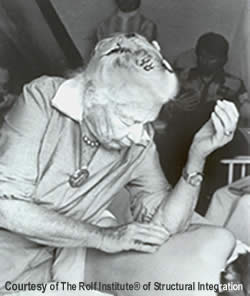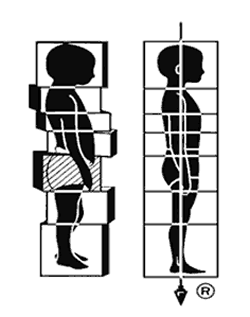Positive Health Online
Your Country

Balanced Body, Balanced Mind: Rolfing - Structural Integration Update
listed in bodywork, originally published in issue 197 - August 2012
Ida Rolf, Rolfing, Structural Integration
One individual may experience his losing fight with gravity as a sharp pain in the back, another as the unflattering contour of his body, another as a constant fatigue, and yet another as an unrelenting threatening environment. Those over forty may call it old age; yet all these signals may be pointing to a single problem so prominent in their own structures and the structures of others that it has been ignored: they are off-balance; they are all at war with gravity.
Dr Ida Rolf, 1977

This photo is courtesy of The Rolf Institute® of Structural Integration;
David Kirk-Campbell photographer
I first encountered the therapy known as Rolfing, or Structural Integration (SI) in 1998, and I had a choice between five practitioners across the country. Since then the number of practitioners in the UK has risen significantly; these days there are easily five times that amount, and the choice is further enriched by the different schools which now prevail. The SI directory lists six principal schools through which most UK SI Practitioners have been trained. These schools all stem from the original work of Ida Rolf, who developed the technique of Rolfing in the mid-20th century. They are:
- The Rolf Institute;
- The Guild of Structural Integration;
- Hellerwork Structural Integration;
- Kinesis Myofascial Integration;
- The International School of Structural Integration;
- Mana Integrative Therapies.
These schools, although having their own styles and idiosyncrasies, all share one common goal: to bring the body into balance and to align it as best as possible in the vertical field of gravity, and let come what may as a result. Indeed, it was the psychological effects of her practice with which Ida Rolf was primarily concerned when she was developing the technique all those years ago.
I am not interested solely in physical structure, although that is really of basic importance especially in terms of physiological well-being. What will be the psychological characteristics of... these more vertical individuals...?
Dr Ida Rolf, 1977

The "Little Boy" logo is a registered trade mark of the Rolf Institute, Colorado - www.rolf.org A full list of all UK Rolfers may be found at www.rolfinguk.co.uk www.rolfingtaichilondon.co.uk/rolfing_who.htm
Ida Rolf - Raising Potential - Evolving Towards The Vertical
For Rolf, the physical and psychological benefits brought about by Rolfing were not the end goal. She theorized that although humans had evolved to become upright creatures, they were not yet quite upright enough, and that by assisting a person to become more vertical - by pursuing a “conscious attempt at evolution” - the person's latent potential would be unlocked. Fundamentally, her concern was that humans used so much resource in simply keeping themselves standing upright; she referred to this as “an ongoing, everlasting war [with gravity]” which necessitated a “constant expenditure of precious human energy”. The heart of her theory lies in the belief that a well-aligned body will no longer be locked in this war with gravity, but will simply float in balance between the Earth's vertical gravitational pulls. The energy will not be avoidably expended, and the person's potential will be released.
For many people, however, the mere physical and mental results of undergoing Rolfing are adequate rewards - and justifiably so. By preventing or correcting misalignment in a person's body, the stress they feel can be limited or even removed completely. But how exactly to bring about this 'evolutionary push' towards the vertical? It is an instinctive notion that the shape of one's body is determined, in essence, by the skeleton; but the skeleton, although being a fundamental and relatively stable element of body structure, is not actually the predominant component to fashions one's form. Rather, it is the softer connective tissues which play the more significant role; the bones of the skeleton are arranged as they are to separate and stabilize these tissues. Upon observation, it becomes apparent that in order for the bones to perform their role most effectively, the connective tissues ought to be arranged in a certain and particular manner. Although the skeleton itself cannot be directly manipulated, the connective tissue is, inherently, far more malleable, and it is this tissue which forms the focus of an SI practitioner's work.
What Connective Tissue is and How it can Lose its Agility
Connective tissue is the most diverse tissue in the body, found throughout, and together with the skeleton it determines one's physical form. That is to say, the limits and shape of one's physical form depend entirely on the limits of the connective tissue within.
One particular type of connective tissue is fascia, commonly referred to as the 'organ of structure'. Fascia changes and adapts in response to demands placed on an individual's body. It can react to physical trauma by producing extra material, in order to enhance stability and support; it can also, however, produce more material than is necessary, which leads to a reduction in mobility as opposed to mere stabilization. This loss of mobility displays itself as a changed postural position and altered patterns of movement, and is precisely what SI practitioners work to overcome.
Applying Pressure - Aligning The Body - How A Rolfing Practitioner Works
Rolfing is a hands-on therapy, in which the practitioner generally works by applying pressure to the supine patient using their elbows, fists and fingers, as they endeavour to release bound-up fascia. Practitioners are able to regard the body as a seamlessly interconnected relationship of parts, and treat it as such – as a whole. Anthony Thompson, a Rolfer based in California, likens the structural manipulation that an SI practitioner effects as “a cross between deep tissue massage and chiropractic work, where one tries to lengthen, hydrate, and relax muscles while aligning the body and redistributing the body ‘load’ in a more optimal way”.
Another important element of the treatment is that of body awareness and movement education; bringing to the patient a conscious sensibility of how they move and how they use their body. This awareness can in fact be one of the longest-lasting effects of being 'Rolfed', and as many devotees of yoga, martial arts, and other high-level body awareness activities will testify, is perhaps one of the most important things a person can learn.
Humans... live within the gravity pull of the earth. They must make their peace with this energy field, whatever it really is. To the extent that they fail to make peace and mistakenly carry on a war, gravity wins every time.
The energy of this field can enhance or dissipate the energy of the individual man. You cannot change the energy field, but you can change the man.
Dr Ida Rolf, 1977
The extent, also, to which our experience of the world depends on our physicality is a thing which remains largely unconsidered. Have you ever stood up on your tiptoes, or crouched down slightly in a crowd, and tried to imagine what life would be like for someone of a different height? It is such a small change to make, and yet the perspective produced can differ enormously from one's norm. Such physical changes are perhaps the most evident that SI work brings about, and the accompanying psychological effects often benefit patients vastly, be they awaited or not.
Physical Effects of a Balanced Body
It is not uncommon to hear of SI patients feeling themselves having grown taller, being more 'centred' - more centrally-weighted - or having the impression that their body's joints have just been 'lubricated'. Rolfing has even been likened to having someone do yoga for you. Of course, the question might also be begged what becomes of all of the energy, previously used to keep oneself upright, when one is better aligned in the field of gravity? The answer is simply that you still have it, and that you can use it for other things. For extra exercise, for extra concentration; simply for feeling more alert and, quite straightforwardly, more energetic. A balanced body can move more freely, fluidly and efficiently, in addition to having less pain. Rolf herself would say that you begin further to realize your true potential.
Form and function are a unity, two sides of one coin. In order to enhance function, appropriate form must exist or be created.
Dr Ida Rolf, 1977
Psychological Effects of a Balanced Body
Feeling less stressed, feeling more free; feeling less nervous and feeling more open: these are all examples of the psychological effects of a less-burdened, better-aligned body. Clinical research has indicated that Rolfing can cause a lasting decrease in state anxiety, but it is really no secret that when we feel better in our bodies we feel better in our minds. Likewise, it is no secret that we react physically to mental and emotional states, and the result over time can be that the underlying emotional tension becomes stored in the body. Through Structural Integration, as with other types of exercise and body therapy, this physical tension can be released and when it is, the underlying repressed/suppressed emotions can also be allowed to surface. And once brought to the surface, they can be addressed and dispelled.
Ida Rolf herself, as mentioned above, was primarily concerned with helping humanity to raise its potential, and the other effects of her work were the icing on the cake. But she conceded that human potential could take forms both physical and psychological, and fully acknowledged the fact that her patients felt better in themselves as a result of her work.
In his book Emotional Anatomy, Stanley Keleman explores the relationship between anatomy and feeling, describing individual form as an interaction between our genes and our emotional history. He also suggests that, due to the link between emotive states and physical well-being, it would be possible to improve our emotive state by working on our physical self – and this is something that S.I. patients, among others, will confirm.
The psychological effects of being in good physical order are well-acknowledged, and Rolfing and Structural Integration are shown to be effective methods of achieving that order. A balanced body really does lead to a balanced mind.
To conclude, a quote from the notice board of my Rolfer – from a Chinese proverb:
Be centred, dear heart, and you shall be protected always.
References
Keleman, Stanley. Emotional Anatomy. Center Press. U.S.A. ISBN 0-934320-10-1. 1985.
Rolf, Ida. Rolfing: The Integration of Human Structures. Dennis-Landman. ISBN 0-930422-10-4 1977.
Rolf, Ida. The Vertical – Experiential Side to Human Potential. www.anatomytrains.com/uploads/rich_media/Rolfing,%20Verticality%20&%20Evolution.pdf 1977.
Weinberg, R.S. and Hunt, V.V. Effects of structural integration on state-trait anxiety. Journal of Clinical Psychology, 35(2). 1979.
www.anatomytrains.com/uploads/rich_media/Rolfing,%20Verticality%20&%20Evolution.pdf
www.atsumihara.com/feedback.html
www.medicalwellnessassociation.com/articles/rolfing.htm
Further Information
For more details regarding Rolfing in the UK, please visit www.rolfinguk.co.uk/ . Many schools of Structural Integration, including those mentioned at the beginning of this article, are now united under the International Association of Structural Integrators.
Comments:
-
janet howarth said..
I found this article both informative and well written;a useful insight into Rolfing.
i would be most interested in reading other related articles by this author.